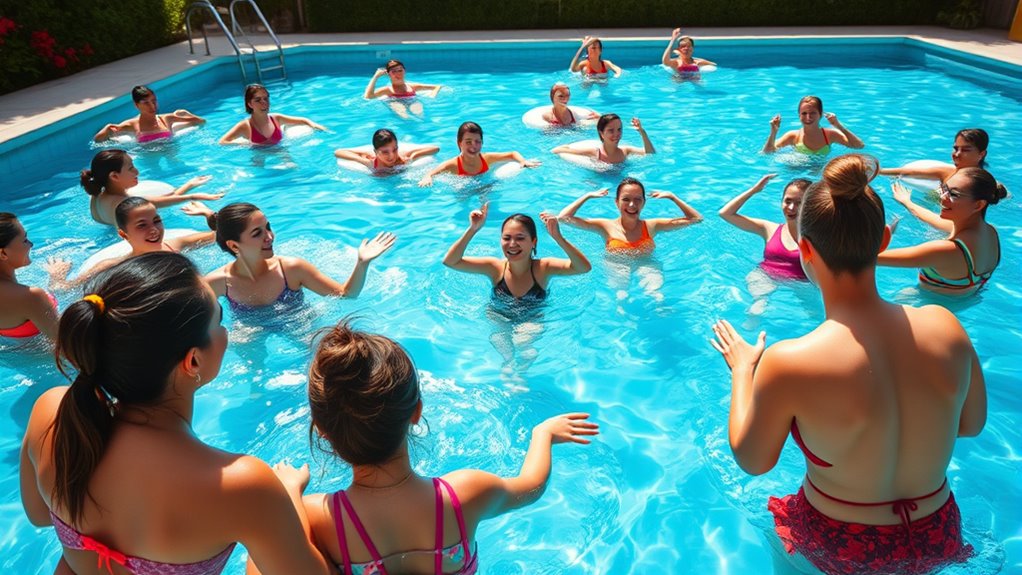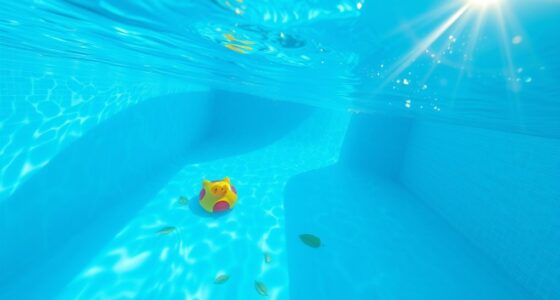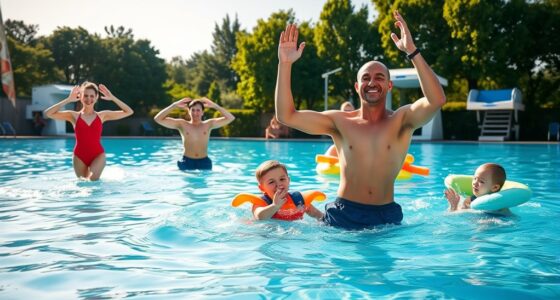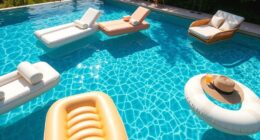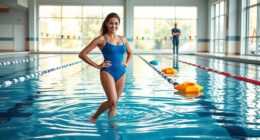You can set up a variety of water fitness classes in your pool to boost your strength, flexibility, and cardio health. Try aquatic therapy exercises like water walking, stretching, and resistance movements with water weights or noodles. Incorporate water aerobics, including jogging, jumping jacks, and side steps, using kickboards and music for motivation. Add balance routines or partner activities for variety. Keep exploring to discover tips on designing effective, enjoyable classes tailored to your goals.
Key Takeaways
- Design a balanced routine combining aquatic therapy, aerobics, and resistance exercises tailored to your fitness level.
- Incorporate equipment like water weights, kickboards, and resistance bands for variety and muscle engagement.
- Use waterproof speakers and music to enhance motivation and create an engaging workout environment.
- Include warm-up, interval training, and cool-down segments to ensure safety and effectiveness.
- Personalize classes with partner routines or balance exercises to promote social interaction and overall fitness.

Have you ever considered how water fitness classes can boost your health while keeping workouts enjoyable? Creating your own water fitness routines at home is easier than you might think, especially when you tap into the benefits of aquatic therapy and water aerobics. These activities are excellent for improving strength, flexibility, and cardiovascular health—all while reducing joint strain. Setting up your pool for fitness classes allows you to customize your workouts, making exercise both effective and fun.
Create personalized water fitness routines at home to improve health and enjoy exercise safely.
Aquatic therapy is a fantastic starting point. Originally designed for rehabilitation, it’s now popular as a low-impact way to build strength and mobility. You don’t need special equipment—just your pool and some basic exercises. You can perform gentle stretching, water walking, or resistance movements using water weights or noodles. Because water supports your body, you experience less joint stress, making this ideal if you’re recovering from injury or dealing with arthritis. Plus, the resistance of water makes even simple movements more challenging, helping you build muscle without overexertion.
Next, consider water aerobics, which is a lively, engaging way to elevate your heart rate. All you need are some water-safe weights, a kickboard, and a good playlist to keep you motivated. You can emulate classic routines like jogging in place, jumping jacks, or side steps—all performed in waist- or chest-deep water. These exercises target multiple muscle groups simultaneously, boosting your endurance and tone. Because water provides natural resistance, your workout becomes more efficient and effective. Plus, the buoyancy keeps you afloat, so you don’t feel heavy or exhausted like you might during land-based aerobics.
To set up a successful water fitness class, organize a schedule that fits your routine. Start with warm-up stretches and gradually add in water jogging or resistance exercises. Incorporate intervals of high-intensity movements with rest periods to keep your heart rate elevated. Using waterproof speakers for music and having a variety of equipment—like water weights, kickboards, and resistance bands—can keep things fresh and challenging. As you get more comfortable, you might add balance exercises or even partner routines for social motivation.
The best part? You can do all this right in your backyard pool, turning a simple swim into a full-body workout. With some planning, your pool becomes a versatile fitness studio. Whether you’re doing aquatic therapy to recover or engaging in water aerobics for cardio fitness, these classes make exercising enjoyable and accessible. You’ll notice improved strength, flexibility, and overall well-being, all without leaving your home. So, plunge in and start customizing your water fitness classes today—you’ll love how fun and beneficial it can be.
Frequently Asked Questions
What Equipment Is Needed for Water Fitness Classes?
To run effective water fitness classes, you’ll need aquatic resistance equipment like water dumbbells, noodles, and resistance bands. These tools enhance water aerobics by increasing resistance and engaging muscles. You might also consider kickboards, pool belts, and waterproof gloves for variety. Make sure all equipment is waterproof, safe, and suitable for different fitness levels. With the right gear, you’ll create engaging, effective water aerobics sessions that boost participants’ strength and endurance.
How Do I Ensure Safety During Water Workouts?
Ever wondered how to make water workouts safe and enjoyable? You should always prioritize pool safety by ensuring proper supervision and clear rules. Use non-slip mats and check water depth to prevent accidents. Regularly inspect equipment for damage, and educate participants on water hazard prevention. Do you see how these steps create a secure environment? Staying vigilant helps prevent incidents and keeps everyone confident and safe during water fitness classes.
What Is the Ideal Pool Temperature for Water Classes?
You should keep your pool temperature around 78-82°F for water classes. This range promotes comfort and safety, making sure water chemistry stays balanced during pool maintenance. Maintaining this temperature helps prevent overheating or chills, ensuring participants stay engaged without fatigue. Regularly monitor and adjust the temperature as needed, especially after chemical treatments, to keep the water inviting and safe for all fitness levels.
Can Beginners Participate in Advanced Water Fitness Classes?
Yes, beginners can participate in advanced water fitness classes, but it’s important they start with beginner-friendly routines. You should communicate your skill level to the instructor, who can then modify exercises using beginner-friendly routines and basic movements. This way, you can gradually build strength and confidence while exploring advanced training techniques at a comfortable pace. Always listen to your body and ask for modifications when needed.
How Often Should I Schedule Water Fitness Sessions?
You should schedule water fitness sessions two to three times a week, giving your muscles time to recover without turning your pool into a competitive swim meet. Keep class durations around 45 minutes to prevent participants from turning into prune-like raisins. By balancing scheduling frequency and class length, you’ll keep everyone energized, enthusiastic to splash in again, and avoid turning your pool into a soggy, overused battleground.
Conclusion
Imagine yourself gliding through the cool, inviting water, feeling every movement energize your body and calm your mind. With these water fitness classes, you can transform your pool into a personal oasis of strength and relaxation. Whether you’re bouncing to upbeat tunes or flowing through gentle stretches, each session leaves you refreshed and rejuvenated. So, plunge in and create your own aquatic sanctuary—where your fitness journey is as endless and vibrant as the shimmering water around you.
